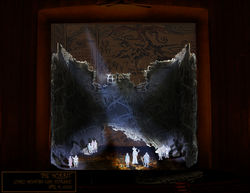KATHERINE STEPANEK
Scenic & Lighting Designer
 |  |  |  |
|---|---|---|---|
 |  |  |  |
 |  |  |  |
 |  |  |  |
 |  |  |
The Hobbit
University of Tennessee - 2020
Written by: Patricia Gray
Based on the classic by J.R.R. Tolkien
Unrealized Scene Design
Scene Designer: Katherine Stepanek
A fantastical story of adventure, danger, friendship, and courage, The Hobbit traverses the world of Middle Earth, following Bilbo Baggins on his epic quest. Journeying from the peaceful, rural Shire, through elven woodlands and ancestral mountains, this play spans the mystical globe as the band of characters encounter legendary creatures and magic artifacts.
Throughout this whole magical world, there are few constants. Myths and magic surround the group in the classical narration style of epic fantasy, with many aspects of the quest taken from Tolkien’s interpretations of Northern mythology (ii.e., Beowulf and Norse legends). Tolkien himself labeled The Hobbit as a “fairytale” of his own making. In this theatrical production, an attempt was made to bring the story back to its origins in mythology and folklore, as opposed to Peter Jackson’s high fantasy film series.
In order to do this, the stage design takes a spin on natural textures and materials, inspired by Sylvain Corentin, the French sculptor. By using the same base materials that you would find in 11th century Viking settlements, including the wood plaster, reeds, and rope, the scenery can be tied to the story’s more traditional roots, as opposed to Jackson’s fantasy landscape. By reconfiguring the usage of these materials for each scene, the story can unfold as the characters travel through the different landscapes.
The scenic elements consist of four main units, manipulated through the show: the mountainous cave entrance, the Shire, the forest, and the cave interior. Each unit is transformed and used in multiple scenes for varying locations, and each is grand in scale, taking up the whole stage. It is an epic adventure, with huge fight numbers, songs, and a cast of characters going up against overwhelming odds. By having the scenery tower over them, having the characters actually climb up the scenery, it gives the audience the impression of a daunting task, more of a doomed feat than one can typically grasp from a staged play.
The house opens to the map of Middle Earth, from the original book. The map is manipulated through projections, to show Tolkien's original sketches and map locations. This map is then projected on the rear wall for the rest of the show, following the group on their epic travels. The only element on stage the whole time, aside from the rear projection screen, is the containment wall, which you can see prominently in scenes 7 and 10 as the cave entrances.
The Shire itself in another unit, this time on a turntable. When the curtain goes up and the show starts, the exterior of the hobbit hole is onstage. As they move into Bilbo's house, the hobbit hole rotates, to show the interior, with a burning fire and a kitchen unit on stage left. At the end of the second scene, the Shire unit tracks offstage right.
The forest unit lives upstage until that moment, and the upstage wall separates, breaking apart to let the forest through. Branches have been reconfigured into these towering tree-like structures, which the dwarves spread throughout and create a camp. The trolls are the first puppets that the audience sees, as they lumber out onto their platform downstage left.
The cave rises out of the trap for scenes 4-6, in the Misty Mountain, turning the space into a winding cavern akin to a mining cave. Right behind the proscenium, a drop comes down to create the cave mouth. Chasing away the dwarves, goblins emerge from the eight entrances throughout the walls and overrun the whole stage. Bilbo ends up on the platform, where he confronts Gollum, the puppet that is only shown in the shadows through backlight coming up from the platform. As he follows Gollum out of the cave, they climb up the walls the goblins had run down. The cave lowers back into the trap as Bilbo and Gollum climb up, so they end up on the main deck as the cave disappears.
When the forest comes out a second time, for the 8th scene, it has become Mirkwood forest, the home of the elves. This time, the trees are covered in fairy lights, becoming a bit more mystical. In the following scene, the dwarves have all been thrown into the elven dungeon. The lights narrow down to a tight spot on Bilbo, as the dwarves quickly climb up into their dungeons in the trees.
The forest tracks back upstage at the dwarves roll in barrels across the stage, ending up at the entrance to the Lonely Mountain. As Bilbo and Thorin enter the cave, the trap raises back up to reveal a cave that has been covered in gold. The Smaug puppet takes up a large section, being controlled by four people. Pyro is hidden in the horns, and the whole body is slightly luminescent, so the creature lights up every time he releases fire. This leads to the epic fight scene in the Lonely Mountain at the end of the show.